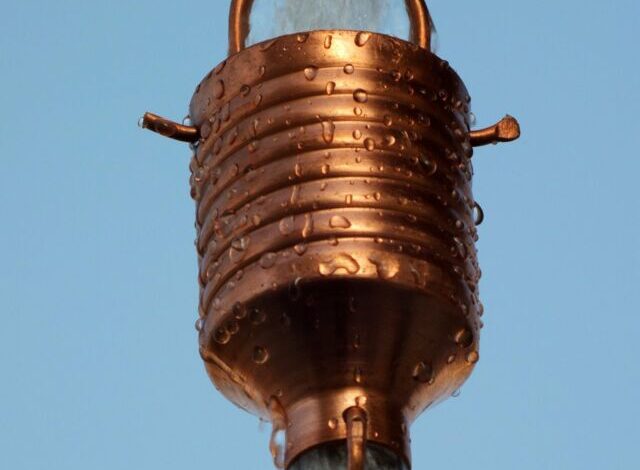Rain chains are a beautiful and functional alternative to traditional downspouts. Originating in Japan, these decorative chains guide rainwater from your gutters to the ground or a collection system in an aesthetically pleasing way. Combining form and function, rain chains can elevate the look of your home while efficiently managing water drainage. In this article, we’ll explore the benefits of rain chains, how they work, and tips for incorporating them into your gutter system.
What Are Rain Chains?
Rain chains are decorative chains or linked cups that replace traditional downspouts on a gutter system. Instead of water flowing through an enclosed pipe, it cascades gracefully down the chain, often creating a soothing sound. Rain chains are available in various materials, including copper, stainless steel, and aluminum, and come in a range of styles to suit any home.
Benefits of Rain Chains
1. Improved Aesthetics
Rain chains add a unique and artistic touch to your home’s exterior. With a variety of designs available—from simple chains to ornate cups—they can complement any architectural style.
- Why It Matters: Rain chains enhance curb appeal and can even become a conversation piece.
2. Functionality
Rain chains effectively channel water from your gutters to the ground or a collection system, such as a rain barrel. While they may not handle extremely heavy rainfall as efficiently as downspouts, they work well in most climates.
- Why It Matters: They provide a functional and visually appealing alternative to traditional downspouts.
3. Soothing Sound
The cascading water creates a calming, natural sound that adds ambiance to your outdoor space.
- Why It Matters: The relaxing sound of rainwater flowing down a chain can make rainy days more enjoyable.
4. Durability
Rain chains are often made from durable materials like copper or stainless steel, which resist rust and corrosion, ensuring they last for years.
- Why It Matters: They require minimal maintenance compared to some traditional downspouts.
5. Eco-Friendly
Rain chains encourage water conservation by easily connecting to rain barrels or other water-harvesting systems. This helps reduce water waste and promotes sustainable living.
- Why It Matters: They offer a stylish way to support environmentally friendly practices.
How Rain Chains Work
Rain chains are installed in place of a downspout, typically at the gutter’s outlet hole. As rainwater flows into the gutter, it follows the chain downward, guided by gravity. Depending on the design, the water either flows down an open chain or collects in small cups, cascading down to the next level.
At the bottom of the chain, water can:
- Flow into a drainage system
- Be collected in a rain barrel
- Be absorbed into the ground via a gravel bed
Choosing the Right Rain Chain for Your Home
When selecting a rain chain, consider the following:
- Material:
- Copper: Develops a natural patina over time for a rustic look.
- Stainless Steel: Sleek and modern with excellent durability.
- Aluminum: Lightweight and available in various finishes.
- Design:
- Open Chain: Simple and minimalist, ideal for modern homes.
- Cup Style: Decorative and effective at capturing water, great for traditional or ornate designs.
- Length:
- Rain chains are typically sold in standard lengths of 8–10 feet but can be customized to fit your home.
- Capacity:
- If you live in an area with heavy rainfall, opt for cup-style chains, which can handle higher water flow than open-link chains.
Installing Rain Chains
Installing a rain chain is a straightforward process:
- Remove the Downspout:
Detach the existing downspout from your gutter system. - Attach the Chain:
Insert the rain chain into the gutter’s outlet hole. Use a hanging hook or installation kit for added stability. - Secure the Bottom:
Anchor the bottom of the chain to a rain barrel, drainage basin, or decorative basin filled with rocks to prevent splashing. - Test the Flow:
Run water through the gutter to ensure the chain effectively channels water downward.
Maintenance Tips
- Inspect Regularly: Check for debris or blockages in the gutter or cups.
- Clean as Needed: Wipe down the chain to maintain its appearance and prevent buildup.
- Adjust Placement: Ensure the chain is securely attached and aligned with the gutter outlet.
Rain Chains vs. Downspouts
| Feature | Rain Chains | Downspouts |
|---|---|---|
| Aesthetics | Decorative and unique | Functional but less attractive |
| Water Capacity | Handles light to moderate rainfall | Handles heavy rainfall |
| Sound | Creates soothing water sounds | Silent operation |
| Cost | Moderate to high | Lower upfront cost |
| Maintenance | Low, mostly aesthetic cleaning | Moderate, requires clearing of clogs |
Are Rain Chains Right for You?
Rain chains are an excellent choice for homeowners looking to enhance their gutter system’s aesthetics and functionality. They’re ideal for areas with moderate rainfall and work beautifully when paired with rain barrels or decorative basins. However, if you live in a region prone to heavy storms, consider combining rain chains with traditional downspouts for optimal drainage.
Conclusion
Rain chains are a stylish and functional addition to any gutter system. They improve your home’s curb appeal, promote water conservation, and create a serene outdoor atmosphere. Whether you’re upgrading your gutters or looking for a unique design element, rain chains are a fantastic option to consider.
Ready to upgrade your gutter system? Explore our blog for more ideas and tips to make your home stand out!

